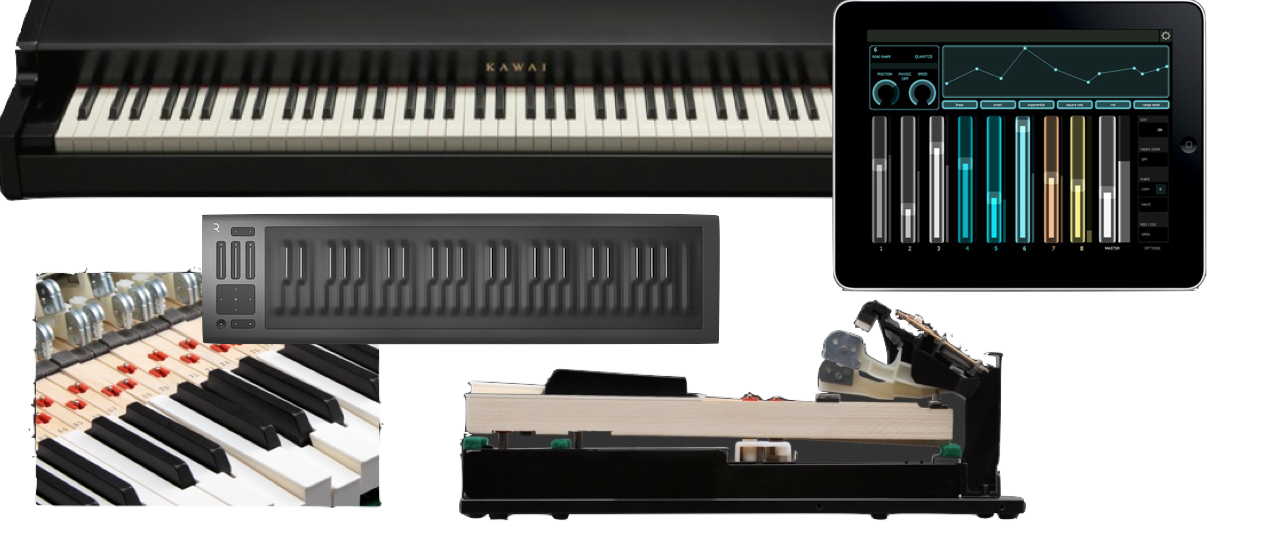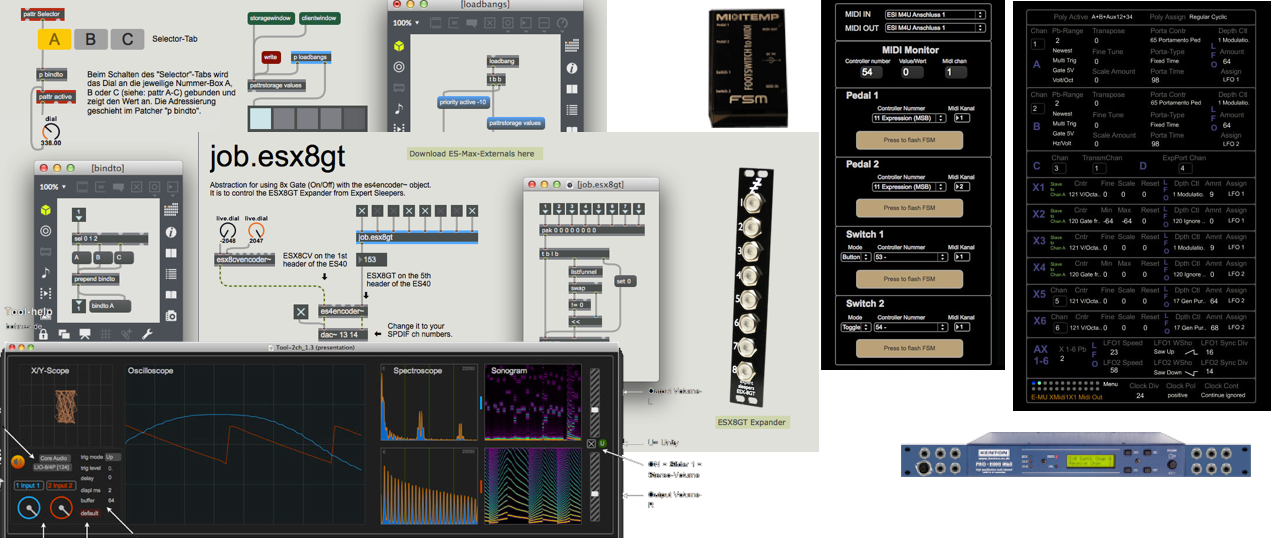The Live-Electronic
Tailored software for Composers, Instrumentalists, Performance Artists and.... for me
Occasionally I receive requests from composers, instrumentalists or studios in order to develop custom software according to specifications or wishes and also commissions for the realization of a live electronic performance. A tailor-made software is best suited for the realization of a compositional idea or an electronic extension concerning the instrumental or vocal performance. Besides the technical accomplishment of the requirements for this software, the connection of the parameters to be controlled with hardware controllers is one of the most intriguing aspects, because administration and spontaneity need to meet here. The result is called an interface and it can be a slider, pedal, keyboard, light or humidity sensor. Or a video camera, or, or.... There are no limits - even robotics could be used. My platform for such things is the "Programming Environment" Max/MSP, my "domain" in software & interface design is creating "instrumental playable interfaces" on the cutting edge. Beeing a pianist (with several second instruments) I have got some distinct ideas about instrumental playing.
During 2018-20 I had programmed software for the pianist / trumpet player Matthias Mainz. A central starting point was to make a virtual piano sound microtonally tunable in order to extend an acoustic grand piano with it and to mix the overall sound in such a way that the result appears as a (single) microtonally tuned instrument. A live looper (sampler) and three buffer sample players were added, all of which can be further manipulated by additional processors ( Filters, Delays, Shifters, RM, Doppler, etc.) interconnected via Matrix and the live input.
PlaYeR / ConTroL
Shown in the video on the left is the " Terminal" - that which appears on the computer monitor. At the top right is the iPad's variable control surface. The controllers (dials, sliders, XY pads, waveforms) chosen on the computer during the creation of a setup are saved as setup presets and can be controlled / played entirely by the iPad (and MIDI controllers). As many modules also come with their own presets to store or recall "live" intermediate settings, I integrated the LaunchKey Mini mk3. The additional keyboard, the controllers and especially the mini pads are a valuable supplement and the "Mini mk4" still finds enough space virtually anywhere.
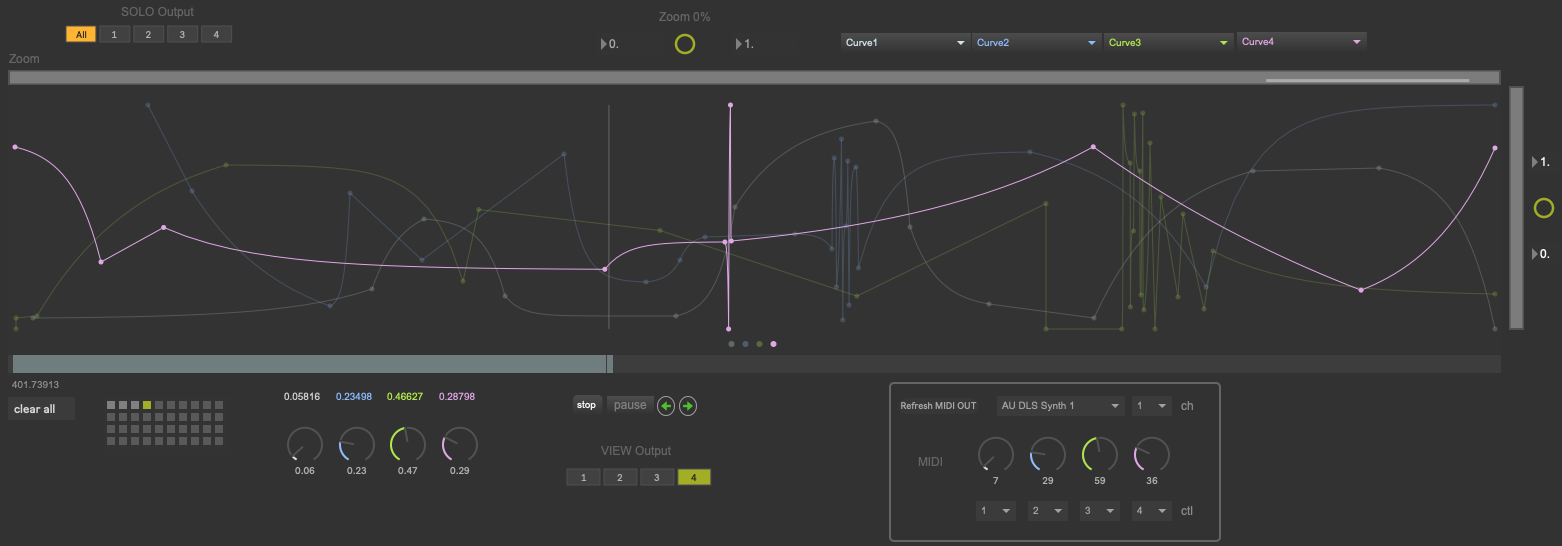
Graphical progressions can also be edited and defined beforehand. These are 4 curves that can be moved individually or simultaneously, either by time control (clock) or by a single slider. On the lower left are the high resolution (10bit / 1024 steps) values (4 sliders from 0.00000 to 1.00000) and to the right are the same outputs, however scaled to 7bit (MIDI, 0 - 127).
Morite
Listen to the live recording of "Morite", a composition by the Sardinian composer Giorgio Tedde - with mezzo-soprano Sylvia Nopper and Thomas Kessler on live electronic.
 From 2006 to 2014 I have programmed several versions of the software used to perform the composition Morite. The picture shows the 2013 version - first time with iPad and iPhone controls. It was also the first time I had turned the computer into a "Terminal" and it no longer needed to be within view for performances. It is also worth mentioning that the app to display the controllers on iPad and iPhone cost only € 4,50 and by using the OSC protocol (Open Sound Control) it featured a 10bit resolution (0-1023) and was much faster than MIDI (7bit, 0-127)! The improvements and simplifications due to the new controller situation were tremendous. The computer monitor no longer needs to be with the performer or sound director, because all relevant information is also displayed on the tablet/iPad. This is a great progress, because the iPad can be used absolutely noiseless and without cable orgy. For this reason, the role of the computer has changed. The screen now shows a terminal - all parameter and other addresses, interfaces and network settings. In addition, I have assigned a visual monitor function for the stage to the computer monitor by using a large peak meter and numerical step display - all important information (e.g. peak meter, step or cue number) can be easily recognized even from a great distance and are invisible to the audience.
From 2006 to 2014 I have programmed several versions of the software used to perform the composition Morite. The picture shows the 2013 version - first time with iPad and iPhone controls. It was also the first time I had turned the computer into a "Terminal" and it no longer needed to be within view for performances. It is also worth mentioning that the app to display the controllers on iPad and iPhone cost only € 4,50 and by using the OSC protocol (Open Sound Control) it featured a 10bit resolution (0-1023) and was much faster than MIDI (7bit, 0-127)! The improvements and simplifications due to the new controller situation were tremendous. The computer monitor no longer needs to be with the performer or sound director, because all relevant information is also displayed on the tablet/iPad. This is a great progress, because the iPad can be used absolutely noiseless and without cable orgy. For this reason, the role of the computer has changed. The screen now shows a terminal - all parameter and other addresses, interfaces and network settings. In addition, I have assigned a visual monitor function for the stage to the computer monitor by using a large peak meter and numerical step display - all important information (e.g. peak meter, step or cue number) can be easily recognized even from a great distance and are invisible to the audience.
 This was the old version of the software from 2006. On the screen you will find (top left) the duplication of all knobs of the motorized fader controller (BCF 2000) - this was a decision in order to be able to operate everything also without a fader bank. All in all, compared to today, quite a lot of work was necessary until the first sound could be heard at all. Also the 2006 setup was already "extremely" cheap at that time. The motorized fader bank was about € 200. Before that, a comparable setup was more than 10 times the price. A golden age had just begun for controllers.
This was the old version of the software from 2006. On the screen you will find (top left) the duplication of all knobs of the motorized fader controller (BCF 2000) - this was a decision in order to be able to operate everything also without a fader bank. All in all, compared to today, quite a lot of work was necessary until the first sound could be heard at all. Also the 2006 setup was already "extremely" cheap at that time. The motorized fader bank was about € 200. Before that, a comparable setup was more than 10 times the price. A golden age had just begun for controllers.
These possibilities increasingly allow the composer to experiment with electronics at home in the best possible quality - this is something that used to be possible to do only in a very few selected electronic studios. Back then, you had to work in tight time frames and at fixed times with technicians or students to realize the electronic part of the composition - often a lottery...
In 2014 MIRA arrived: an "extension" of MAX to the iPad - and it was a really liberating step. Here are two more screenshots of the latest version of my Morite software, realized with MIRA. Even the activation of the software (and the audio system) can now be launched from the Preferences tab on the iPad [ON]. So everything important can be set from the iPad - including effects components - while listening during the sound check (with wireless iPad) - of course from the audience area.
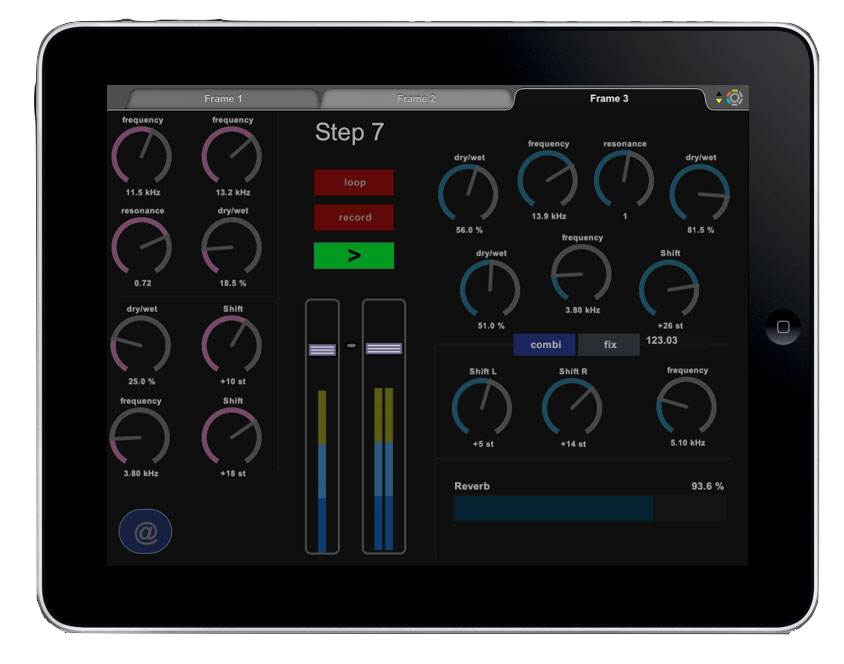
When switching the "Steps" the iPad surface will also change and other knobs, sliders, buttons or XY-vector controllers will appear. The computer is the terminal (see above) and is no longer important in regards to the performance ( it's just the "engine" and the link to audio interface etc.) and it can be placed somewhere else, even out of view, if it is not supposed to do any visual tasks. Now even the preferences for pitchshift, compressor, reverb, slider modes etc. can be edited from the iPad.
For editing, rehearsals or experimenting work with the CPU (the terminal on the computer) the size of the window in the applied computer can be set individually to the used model - because there are so many different monitor resolutions - and the size and position of the window be stored in the preferences (fix window) to not have to redo it each time before starting to work. Also the "full-window" function (borderless, with hidden computer menu) can be accessed. In the meantime I don't use any tabs in the iPad and found a better solution. They cause mistakes and just eat space from the panel on the iPad.
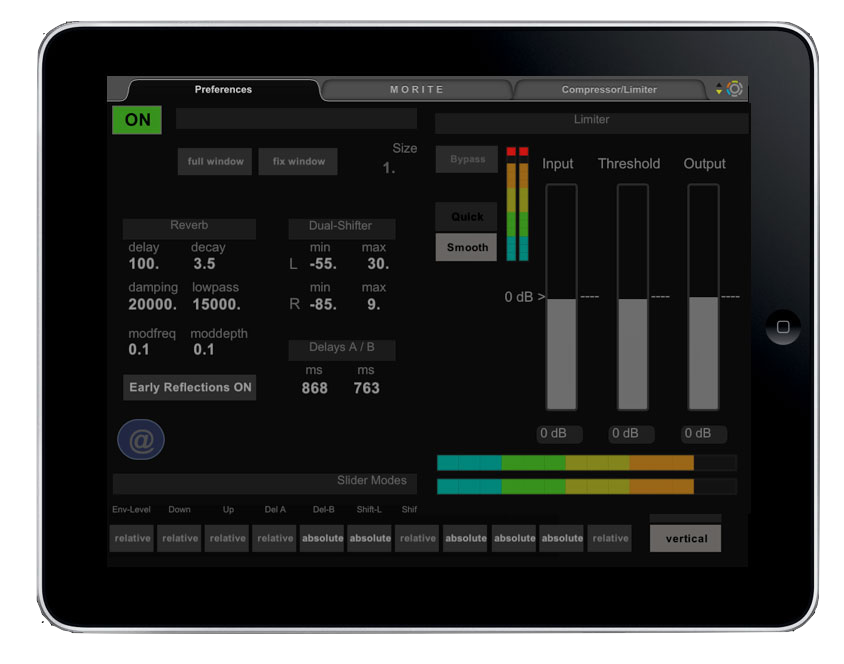
With the ever-present smartphones and tablets, highly sensitive, high-resolution and interactive controllers are now available virtually for free! These very controllers were the biggest (and most expensive) "problem" and a real obstacle in the past. Even though cheap MIDI motorized faders are now available - the possibilities of tablets go much further and finally bring separation from the computer machinery.
Boreo
A video of the piece "Boreo" by Giorgio Tedde, for which I also developed the electronics.
Featured are Miako Klein on various flutes (including a double bass flute!) and Theodor Milkov on drums. The recording was made on November 10, 2007 at the Muziekgebouw Amsterdam.
Miako has become a sought-after instrumentalist, both as a flutist and violinist with enormous stylistic range.
Live Video
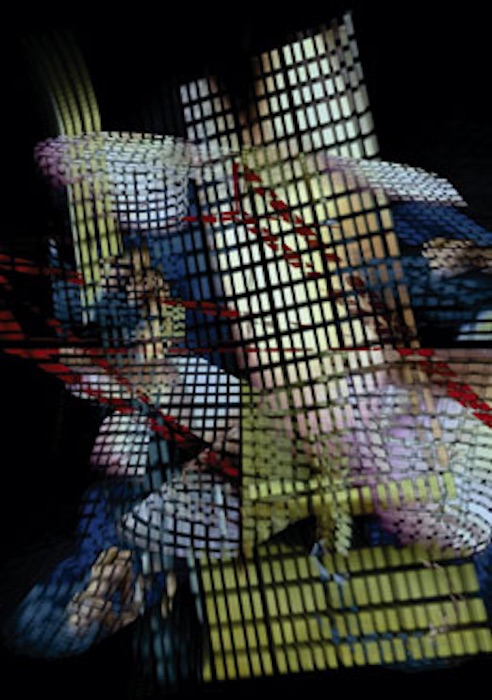 In my work, too, video came more into focus for quite a while (2005) and was a source of great excitement and pleasure for me. It rekindled my old passion of abstract painting, and I was amazed at what I could do with this medium. Of course, like audio, I also prefer to work in real time when it comes to video.
In my work, too, video came more into focus for quite a while (2005) and was a source of great excitement and pleasure for me. It rekindled my old passion of abstract painting, and I was amazed at what I could do with this medium. Of course, like audio, I also prefer to work in real time when it comes to video.
By applying video ( together with music included) the space can become more experienceable, a new overall atmosphere is established and one sense opens the way for the other ones.
However, the whole thing clearly headed in the direction of three-dimensional chess and demanded considerably more time for further exploration. It was very clear that the medium video would broaden and also change its role in the coming years and perhaps at some point - in the finally unhyped existence - could also improve its appeal.
Unfortunately, I constantly face so many open construction areas that I have withdrawn again from live video. If you do all by yourself (electronics), there is already quite little time to further cultivate the musical skills - plus video programming.... oh dear...
Computer also means taking decisions. The visual outcomes have brought a lot of enjoyment (not just) to me.
 The Live Visuals were a little less complicated. On a couple of great nights with the DJs Manon, Goran N. and Pascal Feos in Basel and Lörrach (2005/2006) I hooked up to the audio outputs of the DJs, grabbed a cam and had a great time with my Video Synthesizer CLUTI (german: Computer Licht Und Ton Instrument).
The Live Visuals were a little less complicated. On a couple of great nights with the DJs Manon, Goran N. and Pascal Feos in Basel and Lörrach (2005/2006) I hooked up to the audio outputs of the DJs, grabbed a cam and had a great time with my Video Synthesizer CLUTI (german: Computer Licht Und Ton Instrument).
The minimal/house and techno scene responded overwhelmingly positively to the hallucinogenic, three-dimensional floods of images. Interesting for me to get in touch with this scene! Image: DJ Manon and Pascal Feos.
The available cameras weren't that great yet, especially in dark rooms (and smoking was still accepted). I think it was December 2005 at the Wasserwerk in Lörrach. There was snow outside.
Lighting Control
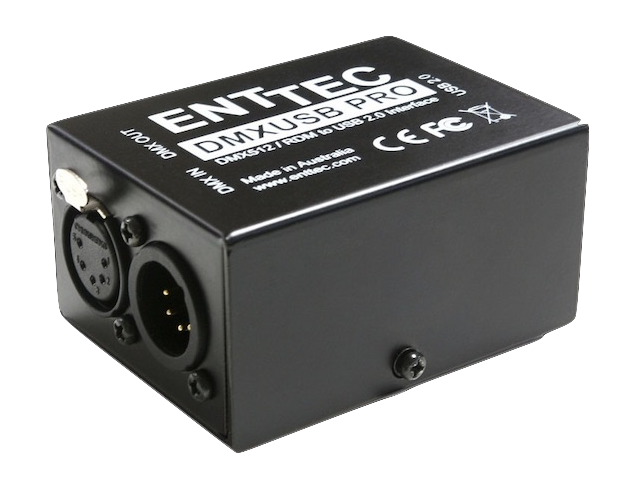 DMX is also a domain that can be handled with MAX. A couple of LED PAR fixtures are very useful for video installations when additional light is required in addition to the video. It is also occasionally good to have a few of these fixtures at concerts. I only use six spotlights (four colored PARs and two warm-white spots) - nevertheless this can save the ambiance, e.g. when only so-called "working light" is available. I only use lights for simple settings, no music control, moving heads or disco balls - so no light show.
DMX is also a domain that can be handled with MAX. A couple of LED PAR fixtures are very useful for video installations when additional light is required in addition to the video. It is also occasionally good to have a few of these fixtures at concerts. I only use six spotlights (four colored PARs and two warm-white spots) - nevertheless this can save the ambiance, e.g. when only so-called "working light" is available. I only use lights for simple settings, no music control, moving heads or disco balls - so no light show.
So far I controlled DMX with my own Max patches. My device of choice for this was the Enttec DMXUSB Pro, which is recognized via a MAX object. One thing that always bothered me was the "construction site feeling" when the DMXUSB Pro was next to the computer - along with a simple DMX transmitter (wireless transmission). As much as I liked being able to control everything from the computer or iPad, over time I became more and more eager to stop doing it with the computer. I also believe the Max-object is no longer available for the current macOS.
While looking for another solution, I came across ADJ's DMX Operator 384 and, because it can do anything I need and can even be MIDI controlled, I ordered it without further hesitation. In fact, it was the only console that wasn't "oversized" or too expensive - and understood MIDI.

It's truly amazing to discover what such a light desk for 100 EUR is capable of these days! My impression is consistently positive. Everything can be set or adjusted very quickly and the stored settings can also be saved externally (e.g. on a USB stick). The basic operation was mastered after just a few minutes. Of course, lighting with DMX Operator 384 is not as programmable as with Max, but I never needed more complex lighting sequences - and DMX Operator 384 can do very, very, much, starting at up to 384 DMX channels. For complex shows I would look for a unit in "a higher league", but for me this is just perfect. If I need to connect it to the computer, I use MIDI. Very good.
I'm really only concerned with "concert lighting". But if the light should be coordinated with the music anyway, using an (extremely slim) MIDI control is of course much more convenient than having all the additional operations of a light desk running in the background on your computer. Also pleasant is that the console can be physically positioned somewhat apart, thus reducing "the construction site" around the computer. I have only had a few practical experiences with it, but I can look to the future with a relaxed attitude.



